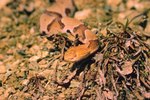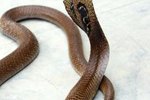If you see a snake in or near the water the next time you’re swimming at your favorite lake, you’ll be glad to know there’s only one poisonous water-dwelling snake in the United States, so chances are it’s not a threat. It’s also easy to determine whether or not the snake you see in the water is poisonous.
It's the Cottonmouth
Of the four venomous snakes found in the United States, the cottonmouth, or water moccasin, is the only one that primarily lives in and near the water. A large, thick-bodied snake, it earned the name cottonmouth due to the white lining visible on the inside of its mouth, and was also dubbed a water moccasin due to its dark tan, brown or blackish skin that sports a variable pattern of dark brown or black crossbands, resembling a moccasin design.
It's a Water Lover
Cottonmouths are primarily found in southeastern freshwater environments, preferring briny lakes, ponds, lowland swamps, river floodplains, marshes and wetlands. They are easily distinguished from nonvenomous water snakes because they swim with their head and part of their upper body out of the water. They also prefer lounging on the water’s edge, while the water snake is commonly found hanging out in tree branches.
It's a Pit Viper
Unlike its nonpoisonous relatives, the cottonmouth belongs to a class of snakes called pit vipers. Pit vipers have visible characteristics not seen in nonvenomous snakes. These include vertically shaped (cat-like) pupils as opposed to round, long fangs, triangular or arrow-shaped heads and a pit or hole between its eyes and nostrils or to the sides of the eyes. This pit is heat sensitive and enables the snake to detect prey and predators.
It's Wise to Stay Clear
According to the Savannah River Ecology Laboratory, research indicates that cottonmouths seldom bite unless picked up or stepped on. Although the snake isn’t typically aggressive, it’s definitely wise to step away and leave the snake alone if you encounter one. Cottonmouths will not run away like many nonpoisonous snakes, but rather, they’ll stand their ground to defend themselves, revealing their cotton-white mouth.
References
- Centers for Disease Control and Prevention: Venomous Snakes
- Texas Parks & Wildlife: Texas Poisonous (Venomous) Snakes
- NC State University/A&T State University Cooperative Extension: Avoiding Watersnake Confrontations
- Mother Nature Network: Is that Snake Venomous?
- SensationalSerpents.com: Identification of Venomous Snakes in the U.S.
- Savannah River Ecology Laboratory: Cottonmouth/Water Moccasin
Writer Bio
A metropolitan Washington, D.C. resident, Bridget Cipollini has been writing professionally for more than 15 years. She received a Bachelor of Arts in journalism from Indiana University of Pennsylvania in 1986. She is a passionate advocate for animals and has volunteered for pet rescue and adoption organizations.





